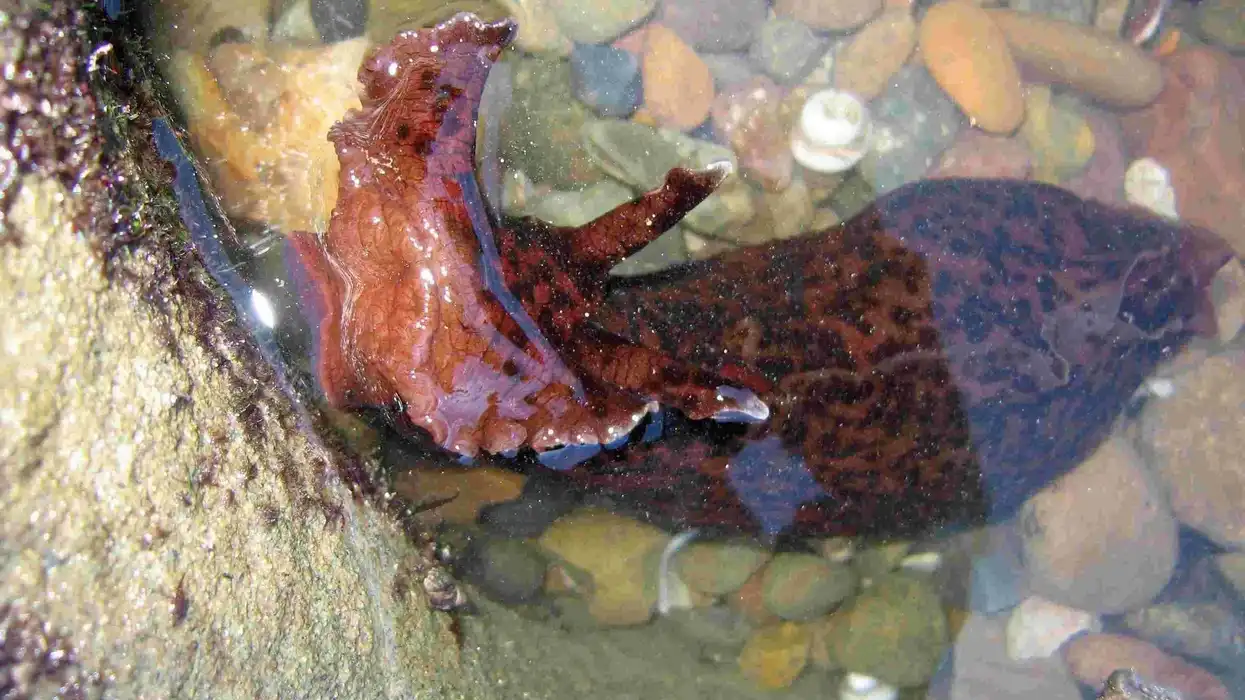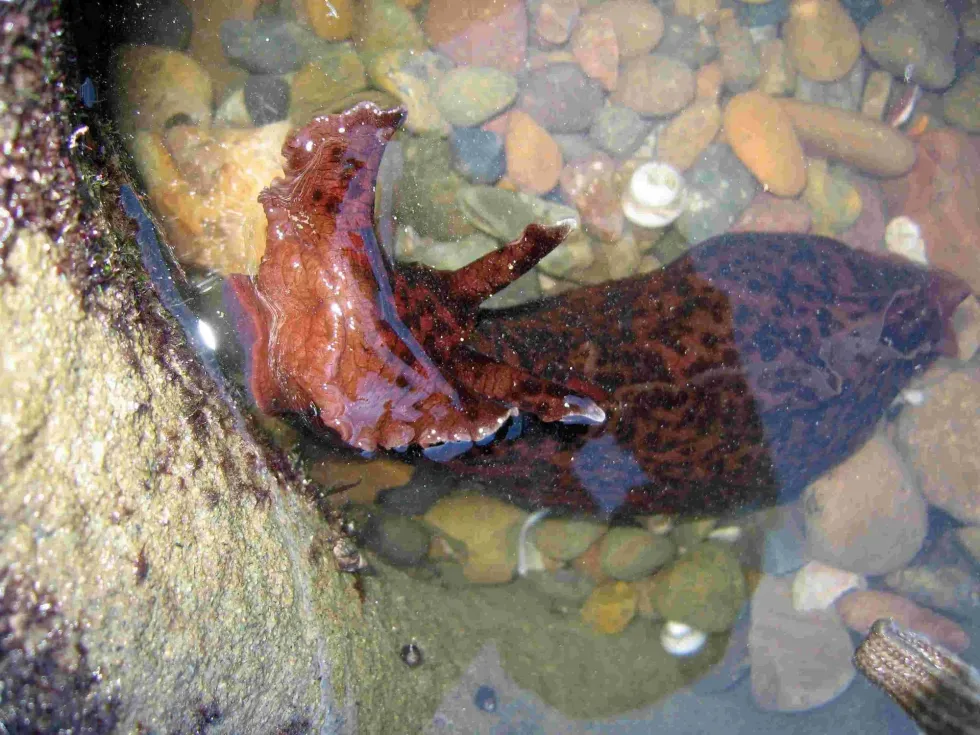California Sea Hare (Aplysia californica) is a sea slug belonging to the Gastropoda class and Aplysiidae family. The scientific name of this creature is Aplysia californica. Interestingly, the Aplysia californica also has another name. The creature is also called California brown sea hare, owing to their darker skin color.
The California brown sea hare is found in large numbers in the coastal areas of California. Unfortunately, we do not really know the exact number of creatures present. They prefer swimming in the shallow waters, feeding on a large variety of algae. In their native ecosystem, they contribute quite a lot.
Reproduction takes place by laying clusters of eggs. The larvae can swim in deep water and constantly feed on red algae until they become mature. These sea slugs are solitary and nocturnal in nature.
Read on to learn some more awesome and interesting facts on the California brown sea hare!
California Sea Hare Interesting Facts
What type of animal is a California Sea Hare?
California brown sea hare, phylum Mollusca, is a sea slug belonging to the Aplysiidae family, which includes all the snails and slugs.
What class of animal does a California Sea Hare belong to?
The sea hare belongs to the Gastropoda class under the phylum Mollusca of the Animal Kingdom.
How many California Sea Hares are there in the world?
Although the exact number of California sea hares is not known, there are more than 35 species of Aplysia recognized worldwide. They are found in abundance along the California coast and are important contributors to the intertidal ecosystem.
Where does a California Sea Hare live?
California brown sea hare inhabits the coastal areas of California, ranging from the Humboldt Bay in the northern part to the Gulf of California. They are also spotted in Mexico and Baa California coastal areas. In short, these sea hare species are native to the Pacific Ocean.
What is a California Sea Hare's habitat?
These sea slug species are benthic and are mostly found in abundance in shallow coastal areas. They also inhabit the rocky shores, and the juveniles can plunge into deeper waters with an average depth of up to 59 ft (18 m). The adults primarily swim in the shallow waters within the lower and middle intertidal zones.
Who does the California Sea Hare live with?
California sea hares are solitary animals and are nocturnal in nature. However, the juveniles are seen in groups foraging on algae and other marine plants. They are highly active at night. This is mainly to avoid being attacked by predators.
How long does a California Sea Hare live?
The life span of a sea hare is very short and is generally a year. Most of the sea slugs perish after giving birth. They can survive for more days depending on the water temperatures. Cooler water is favorable for their life span, as it can delay their reproduction process.
How do they reproduce?
California sea hare (Aplysia californica) reproduces by laying large clusters of eggs. They are hermaphrodites, meaning the male and female slugs are similar in appearance.
Mating takes place in the sea multiple times, and the individuals can attract each other by forming a daisy chain. The congregation takes place by chemical cues. Hundreds of sea hares line up, each receiving or delivering sperm.
The peak mating seasons are summer and spring. Fertilization of the eggs takes place within the sperm storage cavity, which is called the seminal receptacle. After fertilization, the eggs are laid in long gelatinous strings that are bright pink in color.
The clusters of eggs are noodle-like and usually hold about millions of embryos together. Eggs hatch after twelve days, and planktonic larvae are released. The initiation of the egg-laying process is by the method of copulation.
After hatching out of the eggs, each free-swimming larvae is called a trochophore larva. They possess hair-like structures called cilia which help them to swim in the water. These drift for more than 34 days and gradually settle on red algae.
Here they undergo metamorphosis and develop into adults. During this stage, the juveniles undergo rapid development for about three months and feed on a large number of algae and other sea plants. The juveniles reach sexual maturity after 120 days.
What is their conservation status?
The conservation status of the California brown sea hare (Aplysia californica) is not listed in the IUCN Red List. They are present in abundance in the shallow water and coastal areas.
However, due to the increased levels of water pollution, the sea hare species are under threat. California sea hare predators like sharks and other big fish species also pose a threat to them.
California Sea Hare Fun Facts
What does the California Sea Hare look like?
These animals are reddish to greenish-brown in color and have fleshy bodies with muscular feet. They don't have a hard calcified outer shell, which is unlike the California sea hare class.
But they do have a flat internal shell in which all the internal organs, as well as the heart, are stuffed. They have rabbit-like tentacles, which are sensory structures. Parapodia are present over their gills which helps them to locomote.
How cute are they?
Sea slug animals are not cute-looking. They have a bulky body with reddish-brown coloration. Their bulky body is mainly due to their enormous diet, which includes a lot of Pacific marine plants. They are not aquarium animals.
How do they communicate?
Communication of these animals is mostly through tactile and chemical receptors. They can perceive the vibration of the waters and recognize the approaching predators. These marine animal species also have photodetectors, which help them to detect light intensities.
However, they are unable to detect red wavelengths. California sea hare adaptations help them to respond to chemical changes in seawater.
The presence of osphradium near their gills helps them to identify dissolved chemical substances in water. This sensory structure is the main olfactory organ in these animals. They secrete pheromones that help them to attract other individuals of the same kind during their mating season.
How big is a California Sea Hare?
The adults are about 7.87 in (20 cm) in length, which are way bigger in size than the Dotos, a range of marine sea slug species that are not more than 0.6 in (15 mm).
How fast can a California Sea Hare move?
The sea hares move by a flapping motion with the help of their wing-like structures called parapodia. These structures cover the gills and allow water to flow through them.
Although the exact speed of these animal species is not known, they have the ability to withdraw themselves from predators quickly.
This is due to the rabbit-like tentacles, and the structures over their gills called parapodia that help them to detect chemical changes and identify the predators. Their large muscular foot present on the underside of the body helps these animals to locomote.
How much does a California Sea Hare weigh?
California sea hare weighs about 2.20 lb (1 kg). This heavyweight renders them a fleshy body and bulky appearance.
What are the male and female names of the species?
There are no specific names given to the male and female sea hares. They are hermaphrodites and without the presence of any sexual dimorphism.
What would you call a baby California Sea Hare?
A baby California brown sea hare (Aplysia californica) can be called a larva. After hatching out of the eggs, these free-swimming juvenile sea hares are called trochophores that settle on the red algae in the aquarium of the Pacific.
What do they eat?
The California Sea Hare diet consists of red algae and other plant species of the marine habitat. They are herbivores and eat different types of Rhodophyta.
These animals also eat eelgrass and sea lettuce (Ulva), which are found in Morro Bay. Their body color comes from the food they eat.
This is mainly derived from the color of the red algae. They grasp their food with the help of a radula and a pair of jaws. Because of their skin pigment, which is derived from their diet, predators are discouraged and find these animals unpleasant to feed on.
The various predators that have sea hares as food are sea anemones, lobsters, sea stars, and other species. They eat enough of the body of the sea hares before they get a chance to squirt the toxic purple ink.
Are they poisonous?
Sea hares are poisonous because of the toxins that they squirt out. These are a cloud of purple ink, which acts as a defense mechanism in their body.
Would they make a good pet?
Sea hares are not to be kept as pets since they are marine animals. They feed on different algae species that are found in the coastal areas of the aquarium of the Pacific. Therefore, they thrive well in their natural habitats.
Did you know...
The California sea hares have large nerve cells, which are probably the largest in the animal kingdom. Each of these nerve cells is responsible for specific functions. These neurons are under extensive research and are used to study the behavior and memory of these slugs.
Are sea hares venomous?
The California sea hare ink is extremely venomous because of its ability to release purple toxins from its parapodia. This acts as their defense mechanism, and it is squirted out when they are threatened. Due to this toxic substance, predators find them distasteful and unpleasant to eat.
How does the California Sea Hare defend itself?
California sea hares produce a toxic substance, which is deep purple in color. This is squirted out on the enemies when the sea hares are attacked. They are also able to move away rapidly from their predators. They have a large number of sensory structures that help them to identify the chemical changes in water.








